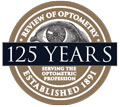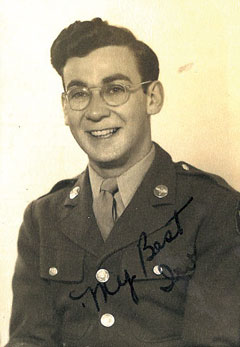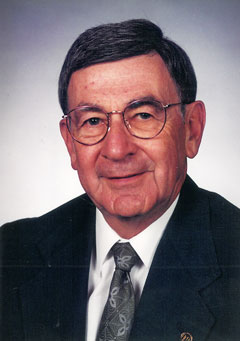 |
“Come in here, Private Bennett, and tell me what eye condition this soldier has.” Those were some of the first words I heard from Major Clark, the ophthalmologist in charge of the Eye Clinic on the B-24 Air Force Base in Clovis, NM in August 1944. I had just graduated from the Pennsylvania College of Optometry, having been deferred from the World War II draft to finish my schooling. The draft board concluded I would be more valuable to the war effort examining eyes than firing a gun.
I went into the room where a young soldier was sitting in the exam chair. He surely did not realize that what was playing out before him was a snapshot of the bitter feelings between ophthalmology and optometry. No sooner had I picked up an ophthalmoscope before Major Clark went one step further, saying, “Don’t ask this soldier any questions—just tell me what he has.” Wow, here I am, a fresh Army recruit with no real-life professional experience, being given a test. And by an ophthalmologist, no less!
 |
| The author in his World War II days—a lowly private despite his doctor of optometry degree. |
“Well,” I said after having a good look at the retina, “if I could ask this soldier if he could see out of this eye and he said he could not, I would say he has an optic atrophy. And if he said he could see out of the eye, I would say he has optic neuritis.”
Major Clark looked at me and grunted as he left the room, “That’s right, Private. But less than 5% of the optometrists in this country would know that.” I replied as he was leaving, “I think you are wrong, Major; 95% would know it.” I am not sure if he heard me. But I was jubilant.
Growing Pains
That interaction occurred more than 70 years ago. Optometry of those days was absolutely nothing like what it is today. Imagine, for a moment, that I was an OD and a private in the Army. The Armed Forces did not recognize me as a professional! So many of my optometric colleagues in the service were like me—practicing optometry with no officer designation.
What has happened to optometry in the seven decades since my incident in Clovis is little short of miraculous. It can be compared to an infant becoming an adult—only much harder and much quicker. This 125th anniversary milestone for Review of Optometry has provided me the opportunity to think about many of the advances and changes that have happened to my beloved profession in my lifetime. Join me in a brief trip down memory lane. If you are a young optometrist, you may read in disbelief about the what and the how it happened. You already appreciate the why it happened!
• Optometry in the 1940s was a drugless profession. Yes, the right to use diagnostic drugs to get a better view of the retina was illegal. And of course, the right to use therapeutic drugs to treat any of the eye diseases that we may have encountered was totally forbidden. Military optometrists who were often allowed to use both diagnostic and therapeutic drugs in the service—even as non-commissioned soldiers—now, as veterans, were annoyed and angry that this privilege was denied to them and their patients. It took until 1971 for Rhode Island to become the first state to grant the legal right for optometrists to use diagnostic drugs; a couple of years later, West Virginia and North Carolina took the logical next step into therapeutic privileges.
History Matters!In 1968, the Philip Morris Company advanced the slogan “You’ve come a long way, baby!” to introduce Virginia Slims, its new brand of cigarettes targeted to women. They were hoping to capitalize on the passion and progress of the emerging feminist movement. Optometry could well co-opt that slogan in celebrating its own progress during that same time period. The current generation of students and new graduates will enjoy a wider range of clinical privileges than any other generation of optometrists. As today’s young ODs hit the ground running, I urge them to appreciate that this enormous advantage was not a birthright—it’s due to the hard work and sacrifice of many who knew our profession could become better, and worked collaboratively with the AOA, its state affiliates, ASCO, ARBO and other groups to make that vision come true. And the key to making optometry’s future even better is to learn from the lessons found in its gritty, hardscrabble history. But these insights need not be limited to the young. ODs of every generation can better understand their own challenges by knowing how their forebears responded to adversity. The Optometric Historical Society (OHS) was established in 1969 to, among other things, “assist in securing and documenting the recollections of those who have participated in the development of optometry.” Hindsight, the official publication of the OHS, appears quarterly to retell the major stories of optometry’s incredible history, and relate many of the otherwise lost “little stories” or the “back stories” behind some of the seminal events in our history. I invite all optometrists to take pride in our profession’s history, to learn from it, and then use it to help optometry continue its advancement. Please visit www.aoafoundation.org/ohs and join the OHS today. Each one of us should take our cue from Winston Churchill, who once said, “History will be kind to me, for I intend to write it.” Know our collective history, then write your own. Start with your membership in the OHS. —Ron Ferrucci, OD, President, Optometric Historical Society |
• These changes did not come easily, because optometry is a state-legislated profession. The opposition to expand optometric privileges seemed to be everywhere. Actually, it came both from within and without. The bitter opposition from ophthalmology was fierce and primarily done for predictable economic reasons. More troubling was the internal opposition. Our profession’s leadership, including the members of the Board of Trustees of the American Optometric Association, were from the “old school” and wanted to maintain the uniqueness of optometry; that is, being no part of medicine and being a drugless profession. In fact, one of my optometric heroes, Dr. H. Ward Ewalt, Jr., when he was the secretary-treasurer of the AOA Board, told me that he personally would go before the Pennsylvania Legislature and testify against any optometric legislative efforts to get the drug use privilege.
• Some decisions that now seem so elementary were often hard to achieve. The profession was flooded with optometrists after the war and it was not easy for the nation to absorb the many optometric veterans looking to enter private practice. The AOA needed to remain strong not only to achieve new gains for the profession, but even more so to ward off legislation that would further restrict optometry. There was strong debate at many sessions of the AOA’s House of Delegates to pass a resolution to encourage these new-to-practice optometrists to join by making the dues for membership free the first year and on a sliding scale for the next few years. A major accomplishment of a strong, unified AOA was convincing the United States Congress to create an Optometry Corps in the Armed Services and automatically awarding an officer ranking to ODs who joined it.
• In my early years, the schools and colleges were, as it is today, a mix of private schools and public universities. Then, there were fewer public colleges that offered optometry courses. And for the few that did, there was a fear in the ’40s that they might follow the example of Columbia University. Columbia had a good optometry school for years but—probably because of pressure from ophthalmology—gave up the offering. Fortunately, the other schools did not go along. Instead, one at a time, both the private and public schools followed the good example of the Pennsylvania College of Optometry and (1) began to extend optometric education to four years; (2) began to require at least two or three years of liberal arts education before matriculating into optometry; and (3) began awarding a Doctorate of Optometry degree.
• The increased years of education made a world of difference as the battle for drug privileges went nationwide in the 1970s. It is hard for me to reveal that my total patient contact (outside my fellow students) in the college clinic in 1944 was 17 individuals. Yes, I had exposure to only 17 patients in my entire college clinical training. The movement to get drug privileges had to be supported by students having more real-life patient contact. This caused the colleges to create externships in busy optometry practices, with some friendly ophthalmologists and in a few hospitals and clinics. The big coup was the development of an externship program with the Veterans Administration. Now it is commonplace for graduating students to examine and treat more than 1,000 patients in their training.
• The poor relationship with ophthalmology seemed to me to be never ending. The dislike, particularly at the organizational level, defies explanation. Personal friendships at the local level between practicing ODs and practicing OMDs was often good. There were many instances of two-way referral systems that worked not only for the benefit of the two professions, but also for the patients they shared. More than not, however, economic competition got in the way of cooperation. The infamous PEN, published by some ophthalmologists from Louisiana, was a vitriolic and malicious magazine. It was distributed to primary care physicians to influence them to not even think about referring patients with eye problems to optometrists. The PEN also was mailed to every legislator in every state each time it was published. When optometric state boards officially requested data to support the printed accusations “from many anonymous patients who went blind because of optometric care,” the responses never came. Ever.
• Probably the major achievement by optometry, after the passage of the DPA and TPA legislation, was the approval by Congress of optometric inclusion in the Medicare Act. It took over 20 years to achieve. Regrettably, the original Medicare Act adopted in 1965 did not include optometry for eye examinations or for the prescribing of eyeglasses or contact lenses. The story of how Medicare did not permit optometrists to participate for more than two decades defies belief. Official ophthalmology convinced official optometry to opt out of Medicare in 1965 as dentistry had done. This could easily be accomplished by not making refractions or eyeglasses covered services. Only after the Medicare bill became law, ophthalmology introduced its medical eye exam that included everything but a refraction! Optometry had been hoodwinked! It took a determined manifold effort by the AOA and others that ended in a move by senator (then Congresswoman) Barbara Mikulski of Maryland to place an “earmark” in the Budget Reconciliation Bill of 1986. That earmark changed the definition of physician to include optometrists for Medicare reimbursements.
 |
| The more familiar visage of Dr. Bennett that decades of ODs have come to know. |
The Biggest Change
I have only scratched the surface of the many changes that have happened during my lifetime. There are many more: the changes in instrumentation, not only for refractive purposes but also for disease detection and treatment are enormous; the optometric print media has changed not only in the subjects covered, but the substance in their coverage; and the congresses and conventions have gone from meetings primarily involving matters of concern for the organization to a substantial number of continuing education lectures. In the old days, there were no state laws requiring attendance of a specified number hours of continuing education lectures for license renewal.
All that being said, I must emphasize that the biggest change in optometry since I began practicing is image. Many optometrists of two generations ago were not really proud of their profession because of the limits on the scope of practice and because of an education that often was not as satisfying as one might expect. The name “optometrist” was not in the vocabulary of many. For years, most city newspapers followed the national AP Stylebook that recommended when to use the honorific Doctor. Editors refused to use the Dr. title before the name of an optometrist in a story the paper was carrying. It has been relatively recent that that has changed.
Today, the prestigious news magazine US News and World Report has listed optometry as one of the top vocations that can be recommended for people seeking a career. Optometry’s image has changed for the better. And those who know the history will appreciate our current high esteem more and more.
Dr. Bennett practiced optometry in Beaver Falls, PA, for 46 years (1946-1992). He also was instrumental in the launch of OptiFair (the precursor to Vision Expo), Optometry Cares—The AOA Foundation and the publication Optometric Management.
